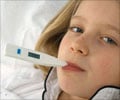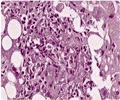Highlights
- Two studies use genetic tests to distinguish bacterial infections from viral infections in children and infants with fever.
- In children, RNA expression signatures helped distinguish bacterial infections from other causes of infections
- In febrile infants age 60 days or younger, RNA bio-signatures could help distinguish serious bacterial infections
- Such genetic means of identification and advances in this field would reduce the morbidity, mortality and costs associated with caring for febrile children.
This study conducted by Micheal Levin, F.R.C.P.C.H of Imperial College, London and his colleagues determine whether bacterial infections in children with fever can be distinguished from other causes by the pattern in which the host genes are activated or suppressed in response to an infection during the inflammatory process and if a subset of these genes could be identified for further diagnostic tests.
Hospitals in the United Kingdom, United States, The Netherlands and Spain participated and children with fever presenting to these hospitals were studied from 2009-2013.
They were places in discovery or validation groups and after microbiological investigations, each group was classified as having definite bacterial infection, definite viral infection or indeterminate infection.
While diagnostic performance was assessed in the validation group, RNA expression signatures using blood samples helped distinguish viral from bacterial infections in the discovery group.
The discovery group had 240 children with median age of 19 months. It included 52 children with definite bacterial infection, and among them 36 (69%) required intensive care, and 92 with definite viral infection, of whom 32 (35%) required intensive care. Ninety-six children had infection of indeterminate origin.
The RNA signature also helped distinguish bacterial infection from childhood inflammatory diseases, systemic lupus erythematosus, juvenile idiopathic arthritis, and discriminated bacterial from viral infection in published adult studies.
Forty six percent of the children in the indeterminate group were classified as having bacterial infection, and among them 95% received antibiotic treatment.
Using transcriptomic signatures for diagnosis requires the translation of multi-transcript signatures into clinical tests suitable for hospital laboratories or at the bedside.
Authors state that, "The disease risk score signature, distinguishing viral from bacterial infections with only 2 transcripts, has potential to be translated into a clinically applicable test using current technology such as polymerase chain reaction.
Furthermore, new methods for rapid detection of nucleic acids, have potential for low-cost, rapid analysis of multitranscript signatures."
"This study provides preliminary data regarding test accuracy of a 2-transcript host RNA signature discriminating bacterial from viral infection in febrile children. Further studies are needed in diverse groups of patients to assess accuracy and clinical utility of this test in different clinical settings."
Study 2 - To identify bacterial infections in febrile infants aged 60 days or younger
Younger infants presenting with fever are at a substantial risk of bacterial infection and the current culture based diagnosis has limitations.
The new study by Octavio Ramilo, M.D., of Nationwide Children's Hospital, Columbus, Ohio, and colleagues examined whether RNA bio-signatures would help distinguish febrile infants with and without serious bacterial infections.
Care for this vulnerable population has been affected by lack of optimal management strategy and has led to unnecessary exposure of many infants to potential harm. The analysis of host response to inflammation triggered by infection has been considered as an alternative. Microarray analysis of blood leukocytes (white cells) helps to identify the pathogen induced host response of RNA bio-signatures.
This study involved febrile infants who were 60 days or younger and were evaluated for fever in 22 emergency departments from December 2008 to December 2010 .
They underwent laboratory evaluations including blood cultures. A random sample of infants was selected for RNA bio-signature analysis. The healthy infants without fever served as controls. Blood samples were collected for cultures and RNA bio-signatures. RNA bio-signatures were defined using bioinformatics tools and febrile infants were classified by infection type.
There were 1,883 febrile infants with a median age of 37 days. RNA biosignatures were measured in 19 afebrile healthy infants and randomly selected 279 infants (89 with bacterial infections--including 32 with bacteremia and 15 with urinary tract infections--and 190 without bacterial infections). Sixty-six classifier genes were identified which helped to distinguish febrile infants with and without bacterial infections in the test set. Ten classifier genes helped in distinguishing infants with bacteremia from those without bacterial infections in the test set.
This preliminary study helped distinguish febrile infants 60 days or younger with or without bacterial infections. To validate the accuracy of the test and clinical use of RNA biosignatures, further research on larger population is necessary
"The results of these 2 preliminary studies represent promissory notes. “Clearly, RNA sequencing and other techniques for RNA quantitation are in the early days of development and evaluation for clinical applications,” says Howard Bauchner, M.D., Editor in Chief, JAMA, Chicago, in an accompanying editorial.
"The substantial decline in the prevalence of serious bacterial infection, following the introduction of conjugate vaccines, has made clinical decision making more difficult--the needle has become much smaller, and the haystack much larger, particularly in young infants.”
However, if the promises of findings reported in the studies by Mahajan and colleagues and Herberg and colleagues are fulfilled by replication and refinement in other rigorous investigations, it may be possible that such advances will further reduce morbidity, mortality, and costs associated with caring for febrile children.
“The day when a parent of a febrile child may do a laboratory test at home, call a physician, and mutually decide if that child should be seen for evaluation may soon be here." he adds.
References:
- Studies explore use of genetics to help determine appropriate treatment for fever in children - (http://www.eurekalert.org/pub_releases/2016-08/tjnj-seu081816.php)













